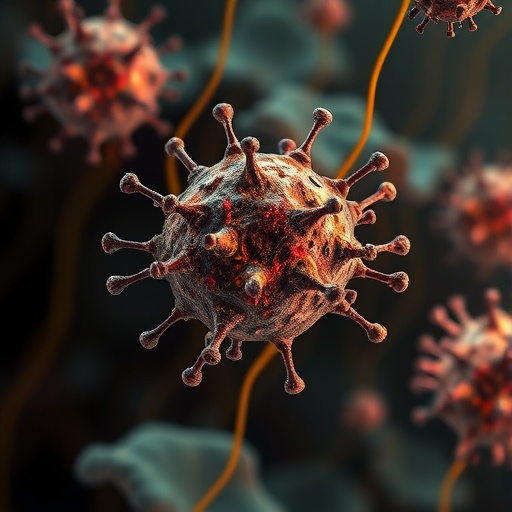In the relentless global battle against COVID-19, understanding the immune protection conferred by antibodies across various viral variants has become paramount. Recent groundbreaking research published in Nature Communications by Zambrana et al. now illuminates the variant-specific antibody responses that correlate with protection against SARS-CoV-2 Omicron symptomatic and overall infections. This work delivers critical insights into how our immune system’s antibody repertoire adapts in the face of new viral challenges, shaping future vaccination strategies in an era dominated by emerging variants.
Since the emergence of the SARS-CoV-2 Omicron variant, which has demonstrated enhanced transmissibility alongside substantial immune evasion capabilities, many public health authorities and scientists have remained vigilant in deciphering how immunity — whether acquired by vaccination, previous infection, or both — stands up against this shifting viral landscape. The study by Zambrana and colleagues meticulously dissects the antibody responses elicited by different vaccine regimens and past infections, specifically targeting Omicron’s distinct sublineages and their role in mitigating symptomatic disease as well as preventing infection altogether.
This investigation leveraged a cohort of individuals tracked longitudinally through infectious waves, employing sophisticated serological assays to quantify antibody titers with precision against multiple variants. By doing so, researchers drew correlations between the magnitude and specificity of antibody responses and clinical protection levels, advancing a nuanced framework beyond generic neutralization-only metrics. Such precision mapping is crucial because not all antibodies confer equal defense across diverse variants, especially with Omicron’s multiple spike protein mutations undermining pre-existing immunity.
One of the pivotal revelations from Zambrana et al.’s study lies in their identification of antibody thresholds that directly correlate with reduced risk of symptomatic infection—effectively establishing immunological benchmarks predictive of protection. This breakthrough allows for the stratification of immune responses, elucidating why individuals with seemingly robust antibody levels against ancestral virus strains may still contract Omicron infections. The study underscores that antibody profiles calibrated to variant-specific epitopes, particularly those localized at the spike protein receptor-binding domain, serve as more reliable correlates of protection.
A technical cornerstone of their methodology involved neutralization assays deploying pseudoviruses engineered to express spike glycoproteins from Omicron subvariants BA.1, BA.2, and more recent descendants. This enabled a granular view of neutralizing capacity and cross-reactive breadth induced by prior vaccinations or natural infection. Intriguingly, data reveal that hybrid immunity—immunity formed by vaccination followed by breakthrough Omicron infection or vice versa—elicited superior neutralizing potency across variant strains, reaffirming the notion that sequential antigenic exposures broaden immune defense.
Beyond neutralization, the team’s additional focus on binding antibody levels through enzyme-linked immunosorbent assays (ELISAs) and other platforms painted a comprehensive picture of humoral immunity’s multifaceted nature. Such multi-parametric profiling revealed that while neutralizing antibodies are central to preventing infection, non-neutralizing antibodies contribute significantly to mitigating disease severity by mediating effector functions like antibody-dependent cellular cytotoxicity (ADCC).
The implications of these findings ripple broadly across vaccine development and public health policy. Current vaccines, primarily designed against early ancestral strains, display waning efficacy over time, especially with the rise of Omicron subvariants harboring escape mutations. Zambrana et al. advocate for the refinement of vaccine formulations and boosting schedules that target variant-specific epitopes and enhance durability of antibody responses, a strategy aligned with emerging data suggesting variant-adapted boosters can restore protection against symptomatic disease.
Moreover, this granular understanding of antibody correlates may assist in the rational deployment of vaccines at the population level, prioritizing individuals whose antibody titers fall beneath protective thresholds. Tailored vaccine campaigns can thus optimize resource allocations and preempt localized outbreaks by bolstering immunity in vulnerable cohorts before surges.
The study’s large, diverse participant base and integration of real-world infection data lend robustness to its conclusions, bridging the gap between laboratory immunology and epidemiological reality. Furthermore, the longitudinal design allowed researchers to track waning immunity and reinfection risk as new variants surfaced, providing a dynamic lens on the evolution of protective immunity over time.
In dissecting symptomatic versus overall infection protection, the research highlights subtle yet impactful distinctions. Symptomatic infection prevention demands a higher antibody hurdle, while lower titers may suffice to limit viral replication and thus reduce transmission risk or progression to severe disease. This finding recalibrates expectations for vaccine effectiveness metrics, advocating for multiple endpoints in immunogenicity assessments.
Zambrana et al.’s work also calls attention to the critical need for improved global surveillance and standardized serological tools able to differentiate variant-specific responses. Such harmonization enables clearer insights into population immunity landscapes and facilitates rapid adaptation of public health interventions in response to variant emergence.
Importantly, while antibody correlates offer a powerful lens, the authors acknowledge that cellular immunity—T cell responses and memory—plays an essential complementary role in durable protection, especially against severe disease. Future studies integrating both humoral and cellular arms will unlock a fuller understanding of immune defense architecture against SARS-CoV-2.
This rigorous investigation into variant-specific immune correlates marks a significant scientific milestone amidst a pandemic that has continually challenged our assumptions. The detailed dissection of antibody profiles, combined with clinical outcome data, enables a predictive immunological framework critically needed to guide next-generation vaccine design and policymaking.
As the virus continues to evolve, such foundational knowledge is indispensable for preempting immune escape and maintaining population resilience. The insights revealed here propel us closer to an era where SARS-CoV-2 may be managed like endemic respiratory viruses, with robust, variant-informed vaccines keeping morbidity and mortality in check.
In summary, Zambrana and colleagues have delivered an incisive, data-driven blueprint highlighting how specific antibody responses to distinct SARS-CoV-2 variants correlate with tangible protection outcomes. This research not only deepens scientific understanding but also provides actionable intelligence to shape vaccination strategies in the face of ongoing viral diversification. Their work exemplifies the essential synergy of immunology, virology, and epidemiology driving innovation in pandemic response.
Subject of Research:
Variant-specific antibody correlates of protection against SARS-CoV-2 Omicron symptomatic and overall infections
Article Title:
Variant-specific antibody correlates of protection against SARS-CoV-2 Omicron symptomatic and overall infections
Article References:
Zambrana, J.V., Mellis, I.A., Shotwell, A. et al. Variant-specific antibody correlates of protection against SARS-CoV-2 Omicron symptomatic and overall infections. Nat Commun 16, 10305 (2025). https://doi.org/10.1038/s41467-025-65235-8
Image Credits: AI Generated
DOI: https://doi.org/10.1038/s41467-025-65235-8
Tags: adaptation of immune system to variantsantibody responses to Omicronantibody titers and protectionCOVID-19 vaccination strategiesimmune response to viral variantslongitudinal studies on COVID-19 immunityOmicron variant transmissibility and evasionpublic health implications of antibody researchresearch on antibody responses to SARS-CoV-2SARS-CoV-2 variant-specific immunityserological assays in COVID-19 researchunderstanding COVID-19 breakthrough infections





